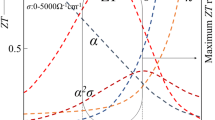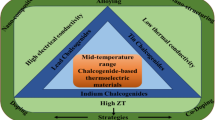Abstract
Thermoelectric materials can easily realize energy savings by converting untapped waste heat into electricity. Unfortunately, however, the coupling of the thermoelectric parameters limits the conversion efficiency. Herein, we fabricated titanium oxide ceramic thermoelectric materials using a simple one-step solid-state reaction between TiO2 and starch at high temperature, and improved the electrical and thermal transport properties simultaneously by adjusting the amount of starch during preparation. With increasing starch, the electrical conductivity and power factor increased and the thermal conductivity decreased significantly. The samples mixed with 7 wt% starch showed rather low thermal conductivity (less than 2.0 W m−1 K−1) and a dimensionless figure of merit (ZT) close to 0.14K at 973 K. When the samples were sintered in an argon atmosphere, the starch was carbonized in situ into carbon and provided a reducing atmosphere, leading to the appearance of oxygen vacancies in the lattice of titanium oxide. The oxygen vacancies increased with increasing starch in the mixture during preparation, which resulted not only in a narrower band gap of titanium oxide but also enhanced phonon scattering.





Similar content being viewed by others
Reference
M. Zebarjadi, K. Esfarjani, M.S. Dresselhaus, Z.F. Ren, and G. Chen, Energy Environ. Sci. 5, 5147 (2012).
D.S. Patil, R.R. Arakerimath, and P.V. Walke, Renew. Sustain. Energy Rev. 95, 1 (2018).
M.A. Zoui, S. Bentouba, J.G. Stocholm, and M. Bourouis, Energy 143, 3606 (2020).
S. Walia, S. Balendhran, H. Nili, S. Zhuiykov, G. Rosengarten, Q.H. Wang, M. Bhaskaran, S. Sriram, M.S. Strano, and K. Kalantar-zadeh, Prog. Mater. Sci. 58, 1443 (2013).
J.F. Zhang, P. Zhou, J.J. Liu, and J.G. Yu, Phys. Chem. Chem. Phys. 16, 20382 (2014).
Y.C. Lai, H.J. Tsai, C.I. Hung, H. Fujishiro, T. Naito, and W.K. Hsu, Phys. Chem. Chem. Phys. 17, 8120 (2015).
Q.Y. He, Q. Hao, G. Chen, B. Poudel, X.W. Wang, D.Z. Wang, and Z.F. Ren, Appl. Phys. Lett. 91, 052505 (2007).
X.D. Liu, D. Kepaptsoglou, Z.H. Gao, A. Thomas, K. Maji, E. Guilmeau, F. Azough, Q.M. Ramasse, R. Freer, and A.C.S. Appl, Mater. Interfaces 13, 57326 (2021).
G.Y. Ji, L.J. Chang, H.G. Ma, B.M. Liu, Q. Chen, Y. Wang, X.J. Li, J.N. Wang, Y.W. Zhang, and X.P. Jia, J. Alloys Compd. 850, 156623 (2021).
A. Verchere, S. Pailhes, S. Le Floch, S. Cottrino, R. Debord, G. Fantozzi, S. Misra, C. Candolfi, B. Lenoir, S. Daniele, and S. Mishra, Phys. Chem. Chem. Phys. 22, 13008 (2020).
S. Thebaud, C. Adessi, and G. Bouzerar, Phys. Rev. B 100, 195202 (2019).
H. Lee, R.C. Seshadri, Z. Pala, and S. Sampath, J. Therm. Spray. Tech. 27, 968 (2018).
Z.H. Yuan, Z.Z. Li, S.K. Xu, W.S. Ma, J.Z. Xu, and G.D. Tang, Ceram. Int. 43, 15454 (2017).
F.M. Hossain, G.E. Murch, L. Sheppard, and J. Nowotny, Solid State Ion. 178, 319 (2007).
M.H. Elsheikh, D.A. Shnawah, M.F.M. Sabri, S.B.M. Said, M.H. Hassan, M.B.A. Bashir, and M. Mohamad, Renew. Sustain. Energy Rev. 30, 337 (2014).
S.J. Pander, G. Joshi, S. Wang, S. Curtarolo, and R.M. Gaume, J. Electron. Mater. 45, 5526 (2016).
L. Hao, Y. Kikuchi, H. Yoshida, Y. Jin, and Y. Lu, J. Alloys Compd. 722, 846 (2017).
H.Q. Liu, H.G. Ma, T.C. Su, Y.W. Zhang, B. Sun, B.W. Liu, L.J. Kong, B.M. Liu, and X.P. Jia, J. Materiomics 3, 286 (2017).
H.Q. Liu, H.A. Ma, F. Wang, B.W. Liu, B.M. Liu, J.X. Chen, and X.P. Jia, Ceram. Int. 44, 8043 (2018).
Acknowledgments
This work was supported by the National Natural Science Foundation of China (Grant 21761027) and the Natural Science Foundation of Inner Mongolia (Grant 2020LH02006).
Author information
Authors and Affiliations
Corresponding author
Ethics declarations
Conflict of interest
The authors declare that they have no conflict of interest.
Additional information
Publisher's Note
Springer Nature remains neutral with regard to jurisdictional claims in published maps and institutional affiliations.
Rights and permissions
About this article
Cite this article
Dong, Z., Li, A., Xiao, S. et al. Simultaneous Improvement of Electrical and Thermal Transport Properties of Titanium Oxide Ceramic Thermoelectric Materials. J. Electron. Mater. 51, 3504–3509 (2022). https://doi.org/10.1007/s11664-022-09642-3
Received:
Accepted:
Published:
Issue Date:
DOI: https://doi.org/10.1007/s11664-022-09642-3




